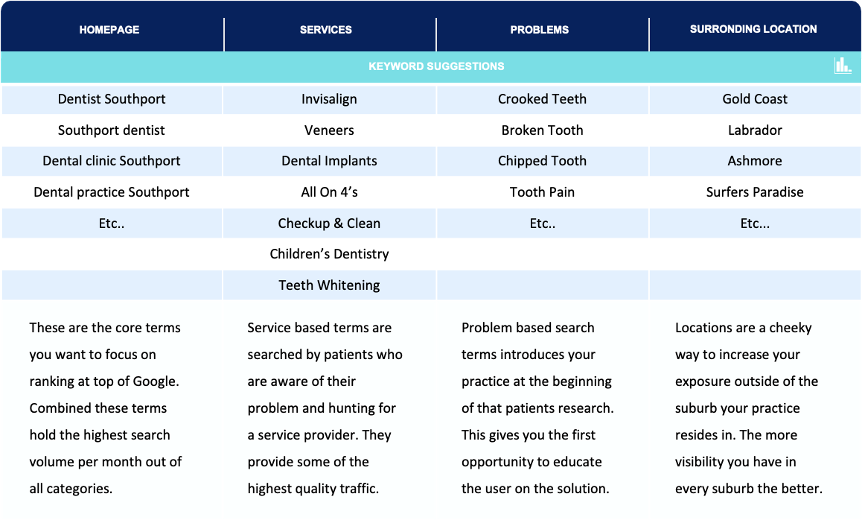What is dental Search Engine Optimisation
SEO (Otherwise known as Search Engine Optimisation) is the strategy of structuring your dental brands’ website to position your website at the top of Google’s SERPs when people search for a dentist.
Why is dental SEO important for your practice?
It is important for you to perform the Best Dental SEO Services on your practice’s website so it can be visible to the community. That way, when people use Google to search for a dentist, you appear as one of the top-ranking websites, giving you more traffic and therefore delivering you more patients.
What you need to know before you perform SEO on your practice's website.
There are 3 main phases to optimising your dental brands’ website.
PHASE #1 Keyword & Market Research:
Keyword and marketing research is performed at the very beginning to decide on what search terms you are going to target with your practice’s website. Below is a list of the different types of searches you can target ranked highest priority to lowest.
Dentist Searches:
- These searches are when the patient is searching for a specific type of dentist such as a ‘general dentist’, ‘cosmetic dentist’ or ‘implantologist’ etc…
Practice Searches:
- These searches are when the searcher is looking for a specific type of dental practice such as a ‘family practice’, ‘cosmetic clinic’ or even just a ‘general practice’ etc…
Service Searches:
- People search with the service name when they are looking for a specific type of treatment such as ‘Invisalign, ‘dental implants’ or ‘veneers’ etc…
Problem Searches:
- These searches are when someone uses the problem they are experiencing as the search term in order to find a solution, such as ‘broken tooth’, ‘toothache’ or ‘crooked teeth’ etc…
Solution Searches:
- In contrast people sometimes search for the solution when they are unsure what the solution is such as ‘straighten my teeth’ or ‘remove wisdom teeth’.
Location Searches:
- Many people use a location in their search when they search in attempt to make the SERPs deliver the most relevant search results.
Informative Searches:
- Lastly informative searches are used by people we aren’t ready to visit a dentist yet but are looking for more information about their query. Informative searches make up the highest percentage of searches on the internet.

It’s important to take your time through these phases so you target all the right keywords from the very beginning. It is much harder to change the strategy later on plus changes to the strategy can create setbacks that waste time.
PHASE #2 Onsite Optimisation:
In this phase, your SEO tech will look to structure your entire dental website (the vehicle) to target the keywords you identified in ‘Keyword & Market Research’ and want to be found for.
This phase is kinda like modifying a car, your SEO tech will look under the hood and assess what can be modified to improve performance. Then they will look to replace your gearbox, the tyres and add a turbocharger so it is equipped to win the race against your competitors and be found at the top of Google’s rankings.
If your dental brands’ website isn’t optimised correctly it will be next to impossible to catch, let alone overtake, your competitors in Google’s SERPs. This means it’s crucial to nail the onsite optimization phases on the first go otherwise it will lead to unsatisfactory results no matter how hard your website is pushed and waste valuable time.
PHASE #3 Offsite Optimisation:
Now that your website has been optimally structured and is targeting the correct keywords (Your destination), now it’s time to push your vehicle and get it moving faster by adding some NOS to the motor (like the cars from ‘The Fast & The Furious’ use to go faster when they click the red button), otherwise known as generating backlinks.
Because there are many websites that target the same keywords, Google uses backlinks as a way to understand which website or page is the most trusted source of information for each keyword.
These backlinks are kind of a 3rd party reference. Depending on who is linking to you, how trustworthy their website is and how well the article has been written, your website will receive a certain level of trust from that link.
So the objective of this phase is to increase your URL (page) and Domain (Website) rating/authority so that Google sees you as the most trusted source of dental information to deliver its users to.
How long will it take to rank on the first page of Google?
This is a very common question that understandably everyone wants to know, but it’s kinda like how long is a piece of string. With so many different variables involved it really depends on your individual circumstances.
Phases #1 and #2 can take anywhere between 2 – 4 weeks to complete depending on the following.
- Website size
- The number of keywords you are targeting.
- Are there pre-existing pages to match keywords or do new pages need to be created?
- Does it require new content to be written?
- Do Images need optimising?
- Are there any structural problems that need to be addressed first?
- Etc…
Once these phases are complete Google needs to index (Scan) your practice’s website to analyse the changes that have been made before any movement can occur. This can take anywhere from a couple of days to a couple of weeks.
After the changes have been indexed your clinic’s website will begin to move. If the onsite has been performed well your SEO will move quite quickly up the rankings until it hits the bottleneck at around pages 2-3 of Google (top 30 results).
From here the movement will start to slow down and will vary dramatically for each individual search term.
Ultimately it can take anywhere from 45 days to 6-12 months to see your website appear in the top positions for your search term. It all depends on how well your SEO has been performed.
What's the best way to track my SEO results?
In order to optimally track the performance of your dental SEO campaign, it’s best to use a variety of different tracking tools to allow you to see the whole equation.
Google Analytics:
To start with you should always set up your website shand connect it to google analytics. This will allow you to track data on the visitors that land on your practices site and how they interact or even track who converts into an inquiry.
Click here to see how to set up your website with Google Analytics.
Google Search Console:
This is the central hub for Google to communicate with your website. They provide data on search results, impressions, clicks and also if there are any errors that are negatively affecting your website.
Click here to see how to set up your website with Google Search Console.
Paid Software:
In order to visually and easily see where your site is currently ranking and all the other variables that are important to track during an SEO campaign it’s best to utilise paid SEO software.
The best ones allow you to pull data from your SERPs, Google Analytics, Search Console and many other platforms and host all the information in one place which is customisable and easy to navigate.
What negatively affects dental SEO?
With over 200 different variables that google takes into consideration there are many variables that can affect the results of your dental practice’s SEO campaign in a negative way.
Website Platform:
The platform your clinic’s website is built in will also contribute to your Search Engine Optimisation performance. If you’re optimising a Toyota Yaris and your competitor has a Maserati or a Ferrari it’s going to be much harder for you to beat them to the top regardless of what modifications you make.
Recommended Website Platforms for SEO
- WordPress
- Squarespace
- Weebly
Website Platforms to Avoid
- Landing page software
- ClickFunnels
- Leadpages
- Unbounce
- Wix (Has Improved but not recommended)
- Duda
- GoDaddy Website Builder (Including other similar builders)
Website Speed:
Websites that take forever to load can be frustrating for the user to experience. This frustration increases bounce rates, which is the percentage of people who land on your site but then leave before it loads. In recent years Google has also made it very apparent that load speed is negative to your SEO and therefore important for you to be aware of.
The basic things that affect poor load speed are:
- Heavy images
- Poor coding
- Slow hosting
If you want to run a quick test to see how fast or slow the load speed of your website is you can visit Pingdom and enter your website URL.
Who will deliver the best SEO best results for my practice?
The fundamentals are the same however SEO actually works differently for every industry. Your rankings will all depend on the market, your competition and what you are bringing to the table.
That’s why it’s always best to work with someone that is not only an SEO god but has quantifiable results and experience in the dental industry which will give you the edge over the other practices that are using a general SEO agency for their campaign.



